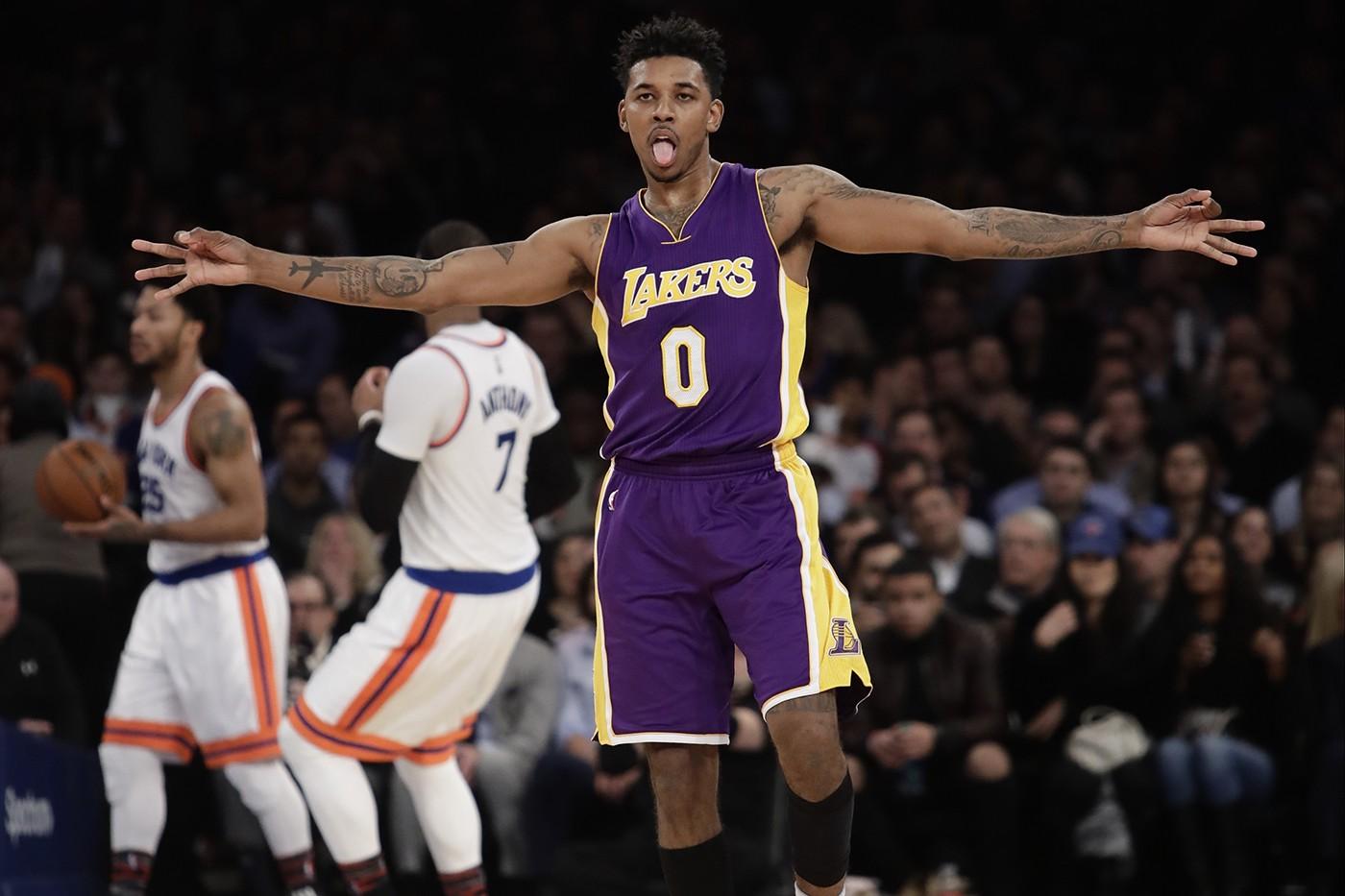
For as much fun as the NBA has been this season, little of that excitement has rubbed off on the Knicks and Lakers. The matchup between two of the league’s marquee franchises Monday was originally supposed to air on TNT, but was wisely bumped from the schedule in favor of the Cavs-Wiz epic and kept as far away from national TV as possible. Both teams have seen any hopes of making the playoffs evaporate since the start of the new year. The Knicks came into the game having lost six of their past 10; the Lakers were 2–8 in that same span.
Prior to the game, Luke Walton acknowledged the inevitable by benching Luol Deng and Timofey Mozgov, the Lakers’ two high-priced free-agent acquisitions in the offseason, for Tarik Black and 2016 no. 2 overall pick Brandon Ingram. With nothing left to compete for this season, the Lakers have no choice but to look toward the future, especially since they will keep their first-round pick in the upcoming draft only if they land a top-three selection.
If Monday was any indication, though, the Lakers’ lineup change could make their subtle tank job less effective than they’d intended. The team played with noticeably more energy en route to a dominating 121–107 win over the Knicks. However, it’s hard to know how much credit to give them for their performance because New York never showed up to play. The Knicks didn’t get back on defense, compete on the boards, or rotate when defending the pick-and-roll; it was as poor an effort as you will ever see from a team in an NBA game. Here are five takeaways from a game between two teams who are ready to put a fork in the season:
1. Seriously, the Knicks Played Zero Defense
Joakim Noah was sitting out with a sore hamstring, and the way the Knicks played defensively on Monday almost justifies their reasoning in giving him $73 million in the offseason. Of course, the Knicks have been just as bad on defense with Noah on the floor this season (allowing 111 points per 100 possessions, which would be the worst mark in the league over the course of the season) as they have without him. There’s not much any one player could do to fix this mess.
It would be tempting to look at the box score and pin the blame on the Knicks’ three centers, Kyle O’Quinn and rookies Willy Hernangomez and Marshall Plumlee. New York was crushed on the glass, giving up 20 offensive rebounds, and outscored in the paint 64–38. However, there’s more than enough culpability to go around; the Knicks seemed to have no idea how to defend as a unit against a ball screen. Black looked like Moses parting the Red Sea on this play:
The play of the game was a ferocious putback slam from Larry Nance Jr. in the third quarter, and it summed up a lot of the Knicks’ problems in one sequence. Brandon Jennings, expecting a screen from Nance that never comes, doesn’t get down in a defensive stance and gets beat at the point of attack. O’Quinn doesn’t rotate over enough to contain Jordan Clarkson’s dribble penetration or stop him from getting a good look at the basket, and no one else helps the helper to prevent Nance from getting a running start at the offensive rebound.
2. Tarik Black, the Plus-Minus God
Black played only 20 minutes Monday, but he had an outsize impact on the game, as the Lakers were plus-34 in his time on the floor, while no one else in the rotation was higher than plus-11. To be sure, plus-minus numbers in a single game can be misleading, and Black was helped by going up against a Knicks starting unit that didn’t look interested in being out there. However, his numbers Monday correspond with what he has done for the Lakers all year.
Black has a net rating of plus-0.6 on the season, which wouldn’t be noteworthy except for the fact that he’s one of two Lakers with a positive figure. Most of his impact has come on defense: The Lakers have a defensive rating of 104.3 with Black in the game and 112.2 without him. At 6-foot-9 and 250 pounds, Black doesn’t have the size of a traditional center and he doesn’t block a lot of shots. But he’s a solidly built player who is tough to dislodge in the post, and his quickness and agility allow him to slide his feet on the perimeter and rotate in the paint to serve as the second line of defense.
Black, an undrafted free agent from Kansas in his third season, is averaging 6.0 points and 5.5 rebounds on 51.6 percent shooting in only 16.2 minutes a game this season. If you equalize his playing time over 36 minutes a game, he’s averaging well over a double-double. He has earned the right to take on a bigger role. While Black doesn’t have the dimensions in either size or skill to be a high-level starting center, he has more than justified the two-year, $13 million contract he signed with the Lakers in the offseason. He looks headed for a 10-year career in the league.
3. Brandon Ingram Showed the Good and the Bad
So much of the Lakers’ long-term future depends on what happens with Ingram, especially if they don’t end up keeping their pick in what should be a fairly loaded draft. He has had an up-and-down rookie season, but that shouldn’t come as a huge surprise considering that he’s one of the youngest players in the NBA (having just turned 19 in September) and he’s almost painfully frail, checking in at 6-foot-9 and only 190 pounds. At this point in his career, Ingram just isn’t strong enough to match up with the biggest players at small forward.
Ingram got a nice welcome-to-the-NBA moment going up against Carmelo Anthony, who immediately went at him on offense, isolating and attacking him in the midpost in the first few possessions of the game. Carmelo was one of the only Knicks who did much of anything on offense on Monday, finishing with 26 points on 10-of-17 shooting, and he was helped by getting into an immediate groove against a rookie who had little chance of guarding him.
Ingram was better on the other end of the floor, with 14 points, seven rebounds, and two assists on 5-of-11 shooting. He was 2-of-5 from 3-point range, an area where he has been inconsistent this season. He’s 4-of-9 from 3 in the past two games, after going five games without making a single shot from behind the arc. Ingram was an excellent outside shooter at Duke, but his stroke has yet to translate to the deeper NBA 3-point line, which has handicapped him on offense. He’s not an elite athlete and he doesn’t have the strength to finish at the rim in traffic, so he’s not going to be effective if he can’t punish a defense from the perimeter. The biggest red flag about Ingram’s shooting might be his 66.9 percent mark from the free throw line, and misses like this aren’t going to help:
Credit Walton with being positive, telling the media after the game: “[Ingram] air-balled a free throw and then had the confidence to knock down back-to-back 3s after that, which is why I think he’s gonna have a lot of success in this league. He trusts who he is as a player.”
4. Derrick Rose Was Terrible
The Knicks offense wasn’t much better than their defense, in large part because they couldn’t consistently collapse the Lakers defense and generate open shots. Carmelo got his points, but the Lakers were mostly content to let him play one-on-one, and no one else on the Knicks roster was able to get much going on that end of the floor. A lot of the responsibility for generating ball movement starts with the point guard, and Rose really struggled in his first game back from an ankle injury, with five points and three assists on 2-of-8 shooting in 32 minutes of action.
Rose is averaging 17.6 points per game on 45.3 percent shooting this season, but he’s not much of a threat from the perimeter, shooting 25 percent from 3, and he’s not distributing the ball much either, averaging fewer assists than his backup, Jennings, despite playing seven more minutes a game. The most puzzling thing about the way Rose plays is how rarely he gets to the free throw line — averaging 3.6 attempts per game — considering how often he attacks the rim. Rose doesn’t generate a lot of contact on drives and he often looks to make spectacular finishes instead of powering through defenders:
Rose is attempting almost half as many free throws as he was during his peak in Chicago, which may be a function of him no longer trusting his body to take the hits necessary to get to the line. He’s going to be an unrestricted free agent at the end of the season, and it will be fascinating to see what the market for him looks like. The Knicks won’t need Rose if they end up taking one of the many point guards available in this year’s draft, and there may not be many teams interested in him as a starter. He would be an excellent sixth man, but coming off the bench would be a difficult pill to swallow for a former MVP who is only 28.
5. Lou Williams Could Really Help a Playoff Team
Everyone is talking about the Carmelo trade rumors that never seem to die, but the most logical trade candidate in Monday’s game was playing for the Lakers. Lou Williams, their sixth man, had 22 points and four assists on 6-of-11 shooting, and his ability to generate offense off the dribble blew the game open at the end of the first quarter. He’s having the best season of his career, leading the Lakers with 18.3 points a game on 43.9 percent shooting and doing what he’s always done: taking and making impossible shots.
Williams is on a reasonable contract, having signed a three-year, $21 million deal before the start of last season, and he could fit on almost any team as an offensive spark plug off the bench. He was great in that role for the Raptors two seasons ago, when he won Sixth Man of the Year, and he could help a number of offensively challenged teams (perhaps the Thunder, Jazz, Grizzlies, or Hawks) in the playoff race who need another initiator on the perimeter. Williams can take over a game at any time and possibly swing a playoff series in the right situation.

